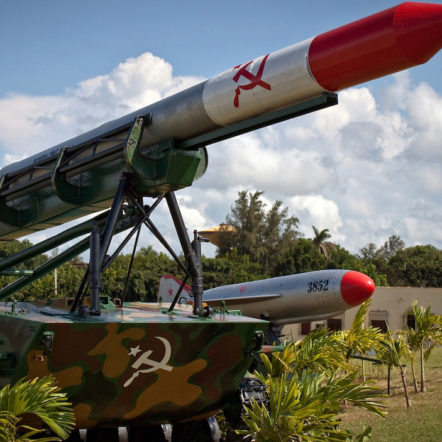Six decades ago, the Cuban Missile Crisis brought the world to the very brink of nuclear holocaust. During October 22-28 1962, Washington and Moscow sparred on the edge of thermonuclear war.
The lessons remain of fundamental importance. They include difficulty of securing accurate intelligence, and the unpredictability of events.
On October 14, 1962, U.S. reconnaissance photos revealed the Soviet Union placing offensive nuclear missiles in Cuba, despite contrary assurances. After the developed film was thoroughly reviewed, National Security Adviser McGeorge Bundy informed President John F. Kennedy
Senior Kennedy administration officials, with the exception of CIA director John McCone, assumed Moscow would never put long-range missiles into Cuba. U.S. actions against Cuba’s communist regime, including secret efforts to kill leader Fidel Castro, alarmed Soviet leader Nikita Khrushchev.
Earlier the White House curtailed Cuba reconnaissance flights, resuming only because McCone insisted. Photographic evidence of the missiles arrived just before they would become operational.
However, there were already indicators, including from reliable Cuba agents, that something of this nature was underway. Senior officials convinced themselves otherwise.
Kennedy and advisers spent a week debating options. At the start of the crisis, there was strong sentiment, especially among the Joint Chiefs of Staff, for a conventional air attack followed by invasion of Cuba.
JFK imaginatively decided instead on a naval “quarantine” as the U.S. first step. His televised speech on October 22 demanded removal of the missiles and announced initial moves, reflecting careful, thoughtful planning. Until the Kremlin agreed to withdraw the missiles, Armageddon loomed.
Years after the crisis, decision-makers from Cuba, the Soviet Union and the United States initiated a series of meetings, which have revealed important new information. Soviet commanders in Cuba already had shorter-range nuclear-armed missiles, and for a time independent authority from Khrushchev to use them if U.S. military forces invaded.
Soviet submarines had nuclear-armed torpedoes. The torpedo would vaporize the launching vessel, which discouraged American interest in this extreme weapon.
Soviet naval officer Vasili Arkhipov refused to concur with submarine commander Valentine Savitsky, who had decided to launch the nuclear torpedo. U.S. surface ships and aircraft relentlessly harassed the sub, which surfaced.
Commander William Morgan, captain of the USS Cory, became Arkhipov’s ally. After communicating an apology for aggressive American actions, he told his signalman, “Keep that Russian bastard happy.”
Bundy’s 1988 book “Danger and Survival – Choices About the Bomb in the First Fifty Years,” revealed JFK privately accepted the Soviet proposed Cuba-Turkey missile trade.
Throughout the crisis, Kennedy demonstrated calm open-minded engagement. His assembled advisers debated a wide range of options. As tensions mounted, the president defused the atmosphere.
Initial pressure for military attack dissipated. Kennedy deftly delayed decision for war, while keeping discussion going and playing for time.
Positive consequences resulted from the crisis. A direct communications “Hotline” between the Kremlin and the Pentagon greatly improved communication. The Partial Nuclear Test Ban Treaty of 1963, overwhelmingly approved by the U.S. Senate, ended nuclear testing in the atmosphere.
Further lessons of the crisis include the importance of disciplined open-minded intelligence work, and communicating with opponents. As always, U.S. presidential leadership is essential.
Today, NATO aids Ukraine in fighting Russia, and our troops are in the Middle East and elsewhere. Yet Americans generally put domestic over international concerns. This parochialism is perilous. In 2017, the Future of Life Institute posthumously honored Vasili Arkhipov. Remember him, salute him. Likewise, Commander Morgan and his calm, focused signalman should be saluted.
At the top, Kennedy deserves great commendation for skill as well as heroism in deflecting almost universal sentiment for war among his top advisers. Likewise, Khrushchev took the essential and brave step of removing the missiles, thus ending the crisis.
Any direct analytic connection between JFK’s Catholicism and his handling of the crisis would be a simplistic distortion. Yet as a combat veteran of World War II, he was directly aware of the horrors of war, and his innate skepticism informed his intense efforts to avoid using military force. This uniquely dangerous high-stakes nuclear confrontation dramatically confirms the Church’s emphasis on restraint, in confronting as well as waging war.
+++
Arthur I. Cyr has an article on the Cuban Missile Crisis in the Autumn issue of “Parameters,” the U.S. Army War College journal. Contact [email protected]




